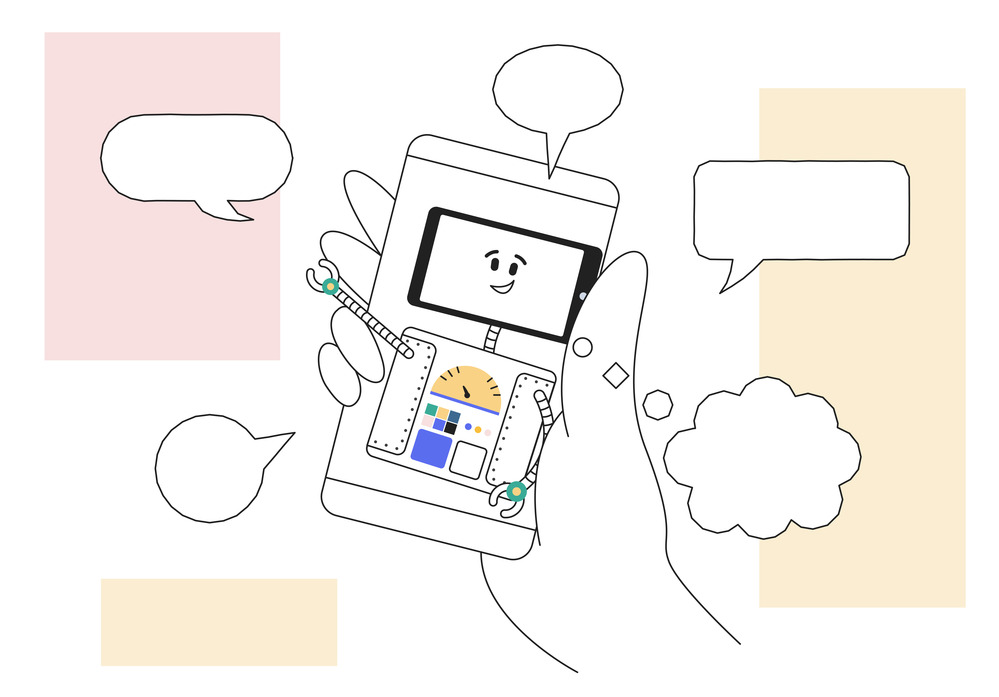How do you craft the perfect LinkedIn profile for social selling? Read this article for more detail about how you can use LinkedIn as a tool to drive sales for your business.
This blog is adapted from the transcript of our popular webinar on social selling, which you can watch here:
What is social selling?
Wikipedia defines it as:
'Social selling is the process of developing relationships as part of the sales process.'
Examples of social selling include:
- sharing relevant content
- interacting directly with potential buyers and customers
- personal branding
- social listening
Sell as you would be sold to
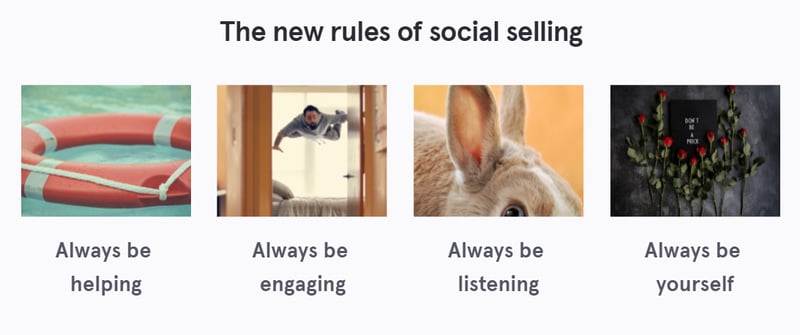
The danger people have is that they think social selling is going to be a magic bullet that will solve all their sales needs and bring hundreds of customers in through the door. They don't think they're going to have to put any work into it; they don't think about the context of other outreach activities, or, importantly, they think that social selling means foot-in-the-door hard selling.
In fact, social selling is about trying to build trusted relationships in the context of a sales process. So if you're using social selling to try and close deals or to move straight to the bottom of the funnel, you're making a mistake. The golden rule is 'sell as you would be sold to.'
Social media allows you to express a little bit of your personality, bring some value to the conversation, build trust, build relationships. You've probably had emails that read like this: 'Hey, let's have a 10 minute meeting. Can I have 10 minutes of your time? Can I interest you in this product?' That's not a great way to start a relationship.
The rule of thumb: 'Always be helping'
This means: contribute something, introduce people, answer questions, share great insights, like other people's insights, comment on things, be involved - give a little to get a little. It's karmic selling. Try and bring a little bit of cheek, charm, wit and personality to it. If you can find some way of being engaging - sometimes that might be stirring up controversy, sometimes that might be just a cheeky turn of phrase - then do so. Don't be bland because there's a lot of noise out there.
Keep an ear open for questions other people are asking and for what other people are saying on social media, particularly on LinkedIn. So it's not only: 'Blah blah, me too, me too, me too'; it's also: 'Ah, that's actually interesting information.'
Above all, you're on social media, so you are supposed to bring some aspect of yourself to that conversation. It doesn't have to be all about products and sales, it can also be: 'This is me, I have this role in the company and I'm having this kind of conversation with you, here's what I do with my life, my interests, my hobbies, the things that I'm following and engaging in.'
Why do it at all?
There's a resistance, certainly in sales circles, to anything that isn't going to bring an immediate gratification and a closed won deal. But, there are various ways in which social media can help sales. It can provide social proof, particularly around content marketing. If lots of people have shared and liked something, that's proof it's good content. When people share your material out to their network, they're effectively endorsing what you have to say. This lets you reach new people who don't already know you, and that's really valuable. It also generates, if done right, significant levels of web traffic and inbound leads, and supports SEO.
These graphs are over 12 months' traffic from social media and contacts into a CRM from social media:
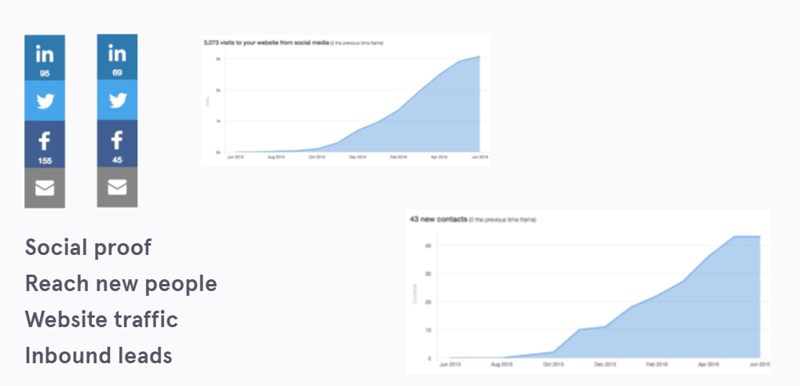
They illustrate the point that if done right, it can actually have a direct impact on sales outcomes.
What is your LinkedIn profile for?
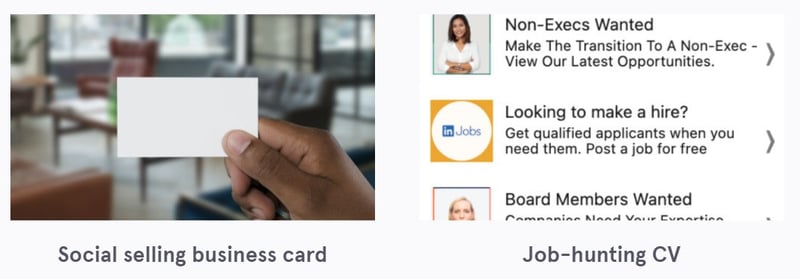
LinkedIn probably thinks of itself as a recruitment tool and an advertising tool. From LinkedIn's perspective, what they want to have is lots of great content on LinkedIn, not on somebody else's site, so readers will click on adverts. They would probably also acknowledge a thought leadership and career development dimension.
But, you are wanting to use it for sales. So you need to translate your default LinkedIn profile from something like, 'Here is my online CV,' to, 'Here is an introduction to me as a person, to me representing my business' positioning, here are my products and services for your interest, my a potential customer.'
Adjust your tone so that your profile talks to your potential customers about things they care about in the language that they might use and they might recognise. What that means is:
- talking their language, using their terminology;
- sharing information and content that's relevant to them;
- making yourself available and accessible, and
- bringing some personality to it by not being too salesy.
Think of LinkedIn as a digital business card. It facilitates a conversation, it provides some reference material, it introduces you, but it sits alongside other activity.
What makes a good LinkedIn profile?
1. The basics
First of all, you need a good, clear profile shot, meaning high quality, without a distracting background, and a clear shot of your face. Photos that are pixilated, blurry, badly shot, badly lit, merged with the background and so on - they're not great.
Get a professional photographer to take your picture and don't use some picture off your iPhone picture library, if you can. It's worth spending the money on that.
And, think about the banner image. Include a relevant, engaging description that doesn't just include your job description. Tell people why they should talk to you.
2. A complete profile
You should try and complete your LinkedIn profile - aim to get 100 percent on that. Add previous job histories, hobbies, interests, certifications, recommendations, introductions, and so on. Build a detailed and rich profile. People might look through that and use it to get to know you a bit, so give them something to read. A flimsy or lightweight profile looks like you didn't really pay a lot of attention to it.
3. Contact information
Especially if you're using LinkedIn to do sales connects, you want to bring some of yourself to that conversation. And, make yourself contactable, which means filling out the contact details so that you've got your blog, your Twitter account, your phone number and your work email address on there.
LinkedIn profile examples
Steve Clayton
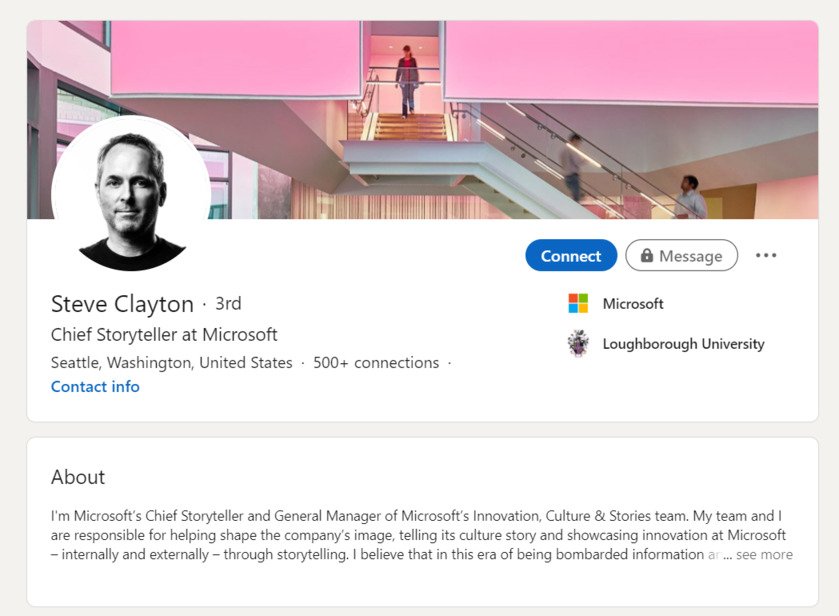
Steve has been at Microsoft for a long time. This profile picture is nice because he's had the background whited out so that you can just see him. It's a black and white photo. It's a really clean social media icon. You see that picture and you'd recognise him immediately. In the description he has gone for a job title, which is not necessarily what I'd recommend in every case, but he's got a great job title. So if you've got that, use it.
He's filled out a nice detailed profile and he's talking a little bit about his activity outside work. This isn't really a job description. It's not like, 'I increased something by this and I did something like that,' it's telling you a little bit about what he's passionate about and what he's interested in. Then, he's got some featured content: his TED Talk, some demos, a Satya Nadella interview.
He's got a boatload of followers, he shares reactions, he engages with people. He's got lots of endorsements from people and lots of recommendations for people. Look at who he following. What's he engaged with? What's he interested in?
Also, this is what a 'good URL' looks like; it's actually got his name rather than a string of numbers.
Guy Kawasaki
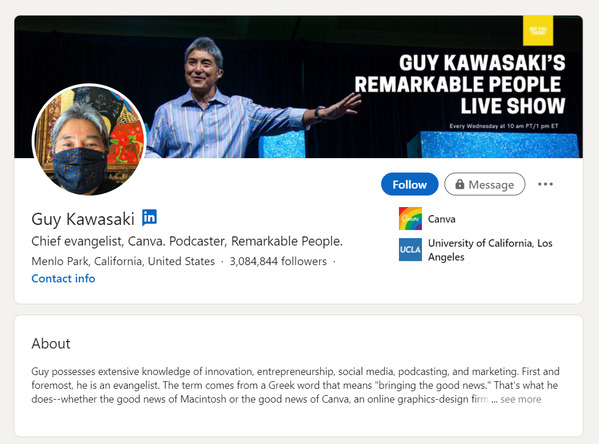
Guy wrote a book called' The Macintosh Way'. Go read it. It's very interesting, very nicely written, and funny. His LinkedIn profile reflects that personality.
On his profile he's described himself very concisely and in an engaging way. Again, he has a boatload of followers. There's a bit of a description here, some really interesting people that he interviews, and there's a biography. As you can see there's lots of useful content, lots of activity, skills, endorsements, recommendations and so on. Look at who he follows: entrepreneurs and thought leaders, bloggers, influencers and investors.
Mitchell Feldman
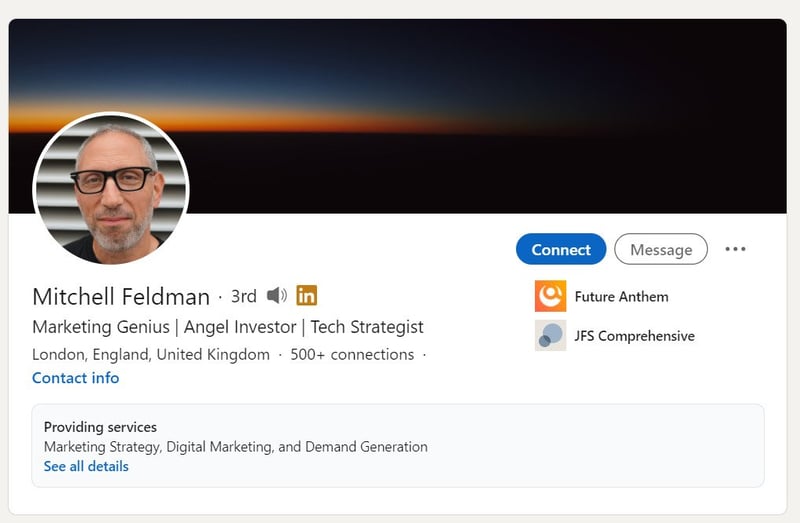
Mitchell is a friend of Articulate Marketing and some kind of LinkedIn genius. He seems to get very good engagement, and when you see him, he's often on his phone LinkedIn messaging people.
He's got the 'rule of three' going on with his description. This is what he's interested in doing, and there's a little bit of chutzpah there with 'marketing genius'. He's got some contact information up there so you can get in touch with him. He's got a very clear proposition.
He is positioning himself as someone who is building a portfolio of investment companies and advisory roles. If you are going to link to a company, you want to make sure that for each of these companies, there is actually a LinkedIn profile for the company as well, and that that is also fully populated.
How to build an audience on LinkedIn
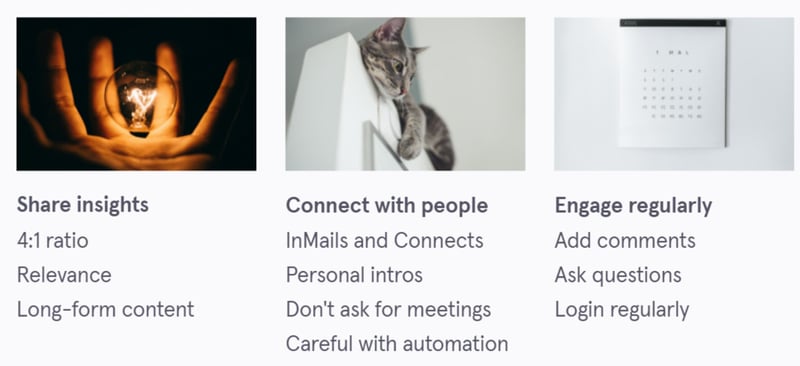
Share useful, relevant content
Share insights with people who are already on LinkedIn. There is value to sharing content that you're hosting on other platforms, or on your blog, on Medium, or wherever. But, there's also value in posting long-form content on LinkedIn in its native format, meaning just writing or copying and pasting long pieces of content into their editor. LinkedIn gives some preference to content that doesn't send you off their website because they want your eyeballs on adverts. They want you to stay on LinkedIn.
So there's an algorithmic advantage to publishing long form content on LinkedIn. At the same time, there is a marketing advantage to getting people to your website, so you want to try and do both.
The four to one ratio is the ratio between stuff that talks about what you want to sell and stuff that talks about what your audience, your ideal customers, are interested in. Do more of the latter. Make sure that you're not just going 'me, me, me' on your LinkedIn.
Build relationships
Comment on a few things, like a few things, and then send an email or message. Try to have a little bit of a conversation on LinkedIn. Don't make your first communication on LinkedIn, 'Can we have a meeting?' There's a quite a high cost to doing that. You can alienate people.
Be careful with automation. Automating LinkedIn is a breach of LinkedIn's rules, so they catch you at it they might kick you off, which wouldn't be great for anybody. You can safely use some auto-responder tools, sparingly, but they can only augment a human presence on LinkedIn, they can't replace it.
If you want to do LinkedIn social selling, you have to be on LinkedIn. Ideally, you want to be logging in every few days, maybe once a week at a minimum.
Use Fizz+Ginger (formerly known as HubToolkit)
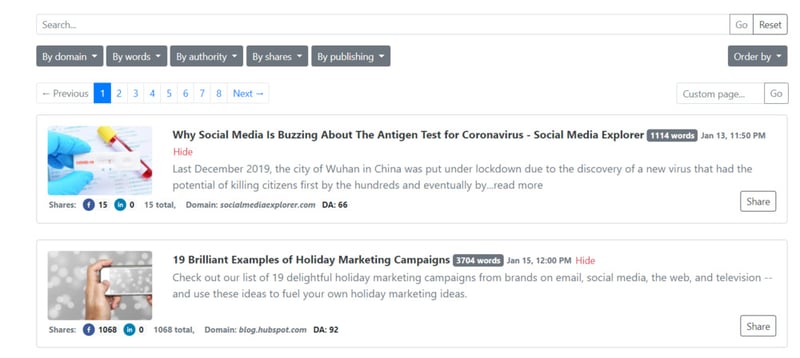
If you're going to curate content onto LinkedIn and you have HubSpot, we have a tool called Fizz+Ginger, which is on our website, and also at fizzandginger.com. This collates relevant content and allows you to share it through HubSpot to LinkedIn, Twitter and Facebook to do that curation of relevant third-party content. There's a free plan and there's a somewhat cheap paid plan. There are other tools available, but that's one that we built and like to use. There we go: plug over!
How to pivot to social selling
At some point you're going to want to move from building a relationship to saying, 'I've got something you might be interested in. Would you like a conversation?' To do that, you need to personalise and pay attention.
Personalise your message
Personalisation means looking at their profile and finding something relevant to say about them. For example:
'I saw on your profile that you have just changed job titles. Congratulations. I wanted to introduce myself because I help other people in your role in other clients. Would you be interested in opening a discussion?"'
Notice you're not asking for a meeting. All you're asking for is a yes or no answer at this point. It's a very low-cost first step. You've personalised that engagement by showing some investment in that relationship because you've done your research. Sell as you would be sold to. Do as you would be done by.
Use meeting calendars
If you are going to ask for a meeting either on LinkedIn or via email, don't try and broker the time for that meeting, just send them something like a HubSpot calendar link so they can go into your calendar and pick a time that works for them. It speeds things up and it takes all that communication faff around setting meetings away. And, it lowers the barrier that is actually booking the meeting for them because they can find a time, they don't have to spend three emails fixing it for you.
LinkedIn message templates
In our own sales team, we use LinkedIn as one touchpoint in a 8 - 10 touch-point sales sequence that will involve a LinkedIn connect, a LinkedIn message, two or three phone calls and three or four emails. For us, our first connect message would be, something like: 'I see you've just downloaded something on our website, so I'm just introducing myself on LinkedIn, or, 'I see we have this person in common.'
Here are four LinkedIn message templates you can use:
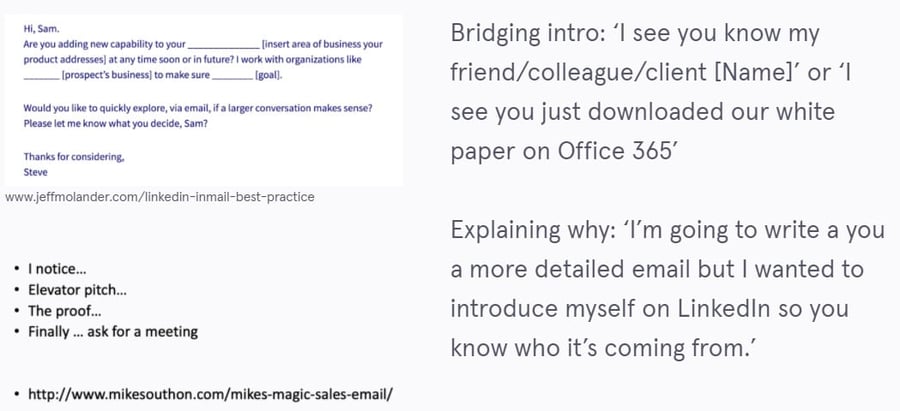
We'll leave you with one last piece of advice: use LinkedIn for introductions if you've connected via referral or at an event. That way, you're actually sharing something about yourself as you go into the sales conversation, and you're also getting a chance to learn a little bit about the person you're talking to if they have a LinkedIn profile and they connect with you.
Articulate's services
We can help you build a social media audience for your company. Our services include social media planning, sharing, curation and even videos. We can help with content creation to drive social media, and of course, we have sales enablement services, so we can integrate LinkedIn selling into your marketing and into your sales processes. So if you want any help with that, get in touch.
